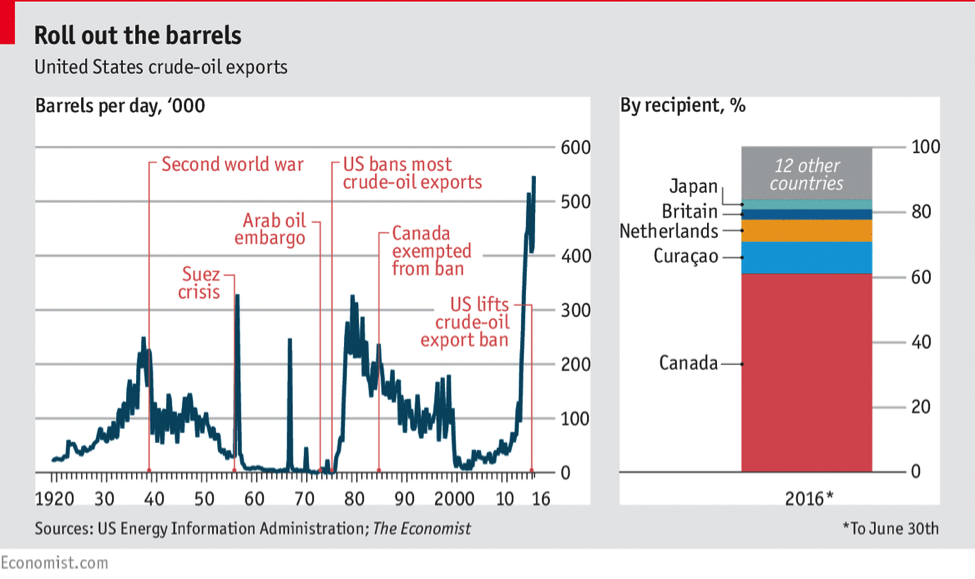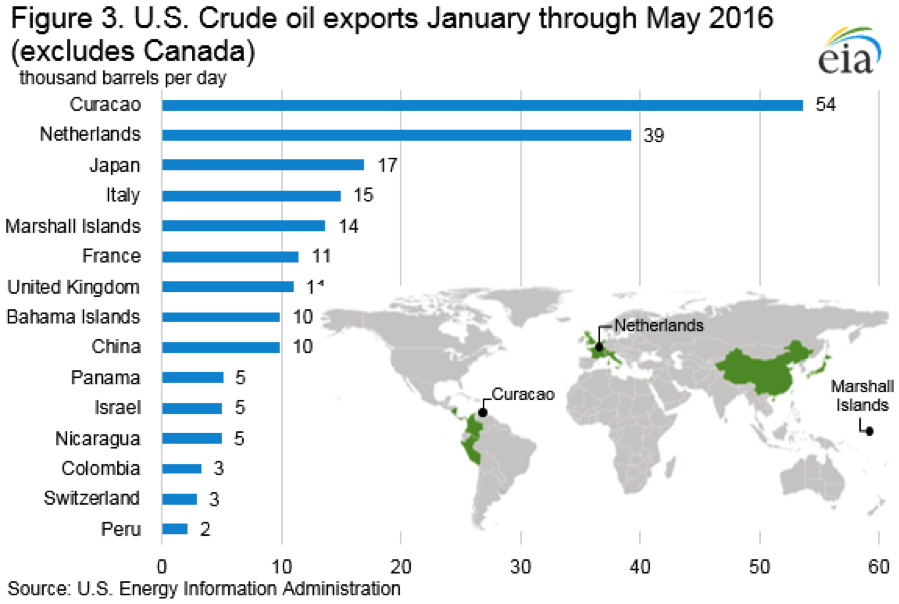Congress lifted the ban on exporting U.S. crude oil in the omnibus spending bill passed last December, allowing crude oil to be exported to countries outside of North America for the first time since the mid-1970s. Despite some modelers at the Energy Information Administration projecting that lifting the crude oil export ban would result in some additional exports if the price spread between West Texas Intermediate (WTI) and Brent crude oil exceeded $6 to $8 a barrel,[i] the United States is exporting crude oil even when the WTI price is just slightly less than the Brent price. In fact, the United States started exporting crude oil fifteen days after the ban was lifted when a tanker left the port of Corpus Christi, Texas for France.[ii] In the first 5 months of 2016, U.S. crude oil exports averaged 501,000 barrels per day, 9.4 percent (43,000 barrels per day) more than in 2015.[iii]
Canada is the main recipient of our crude oil exports and has been since 1985 when crude oil exports to our northern neighbor were permitted. However, for the first 5 months of 2016, U.S. crude oil was exported to 16 different countries, six more than in 2015 and double the number of destinations in 2014. Crude oil exports to destinations other than Canada were allowed if they were re-exported volumes of foreign crude or crude oil produced in Alaska, which was exempted from export restrictions in 1996. In March 2016, crude oil exported to countries other than Canada exceeded those to Canada for the first time since April 2000.
 Source: http://www.economist.com/blogs/graphicdetail/2016/08/daily-chart-9
Source: http://www.economist.com/blogs/graphicdetail/2016/08/daily-chart-9
Countries Receiving U.S. Crude Oil
The top non-Canadian destination for U.S. crude oil in 2016 is the island of Curacao, where Venezuela operates a refinery. Venezuela mixes U.S. crude oil with its heavier crude oil, which is more difficult to refine. After Curacao, the Netherlands is the next biggest non-Canadian destination for U.S. crude oil, averaging 39,000 barrels per day for the first five months of 2016. The Netherlands has 2 of the 3 cities that make up the large refining and petroleum product trading hub known as the ARA (Amsterdam, Rotterdam, and Antwerp). Italy, France, and the United Kingdom rank in the top seven non-Canadian destinations for U.S. crude oil exports so far in 2016.
Interestingly, the Marshall Islands in the Pacific Ocean is the fifth-largest non-Canadian destination for U.S. crude oil exports, averaging 14,000 barrels per day through May 2016. The Marshall Islands have no refineries and, as such, they serve as a holding point for Asian deliveries or as a location for ship-to-ship transfers for deliveries to Asia. When cargoes undergo ship-to-ship transfer or do not have a buyer prior to loading, their destination is listed as the location of the transfer. Japan and China are the main recipients of U.S. crude oil in Asia so far this year.
Source: EIA, http://www.eia.gov/petroleum/weekly/archive/2016/160810/includes/analysis_print.cfm
Conclusion
Despite the narrow price spread between WTI and Brent crude oil, opportunities for U.S. crude oil exports can arise from shipping options. The current cost of booking tankers for a spot shipment is the lowest since 2009. Time charters where a vessel’s time has been paid for a set period at a fixed cost can operate independently of tanker rates. Also, back-haul voyages, where a normally empty vessel returning to port brings cargo with it, can be discounted from regular tanker rates. These options have made U.S. crude oil exports over 9 percent higher so far this year over last year’s volumes.
[i] Institute for Energy Research, September 9, 2015, https://www.instituteforenergyresearch.org/analysis/eia-study-supports-lifting-oil-export-ban/
[ii] Economist, Where America Exports Its Oil, August 11, 2016, http://www.economist.com/blogs/graphicdetail/2016/08/daily-chart-9
[iii] Energy Information Administration, This Week in Petroleum, August 10, 2016, http://www.eia.gov/petroleum/weekly/archive/2016/160810/includes/analysis_print.cfm




